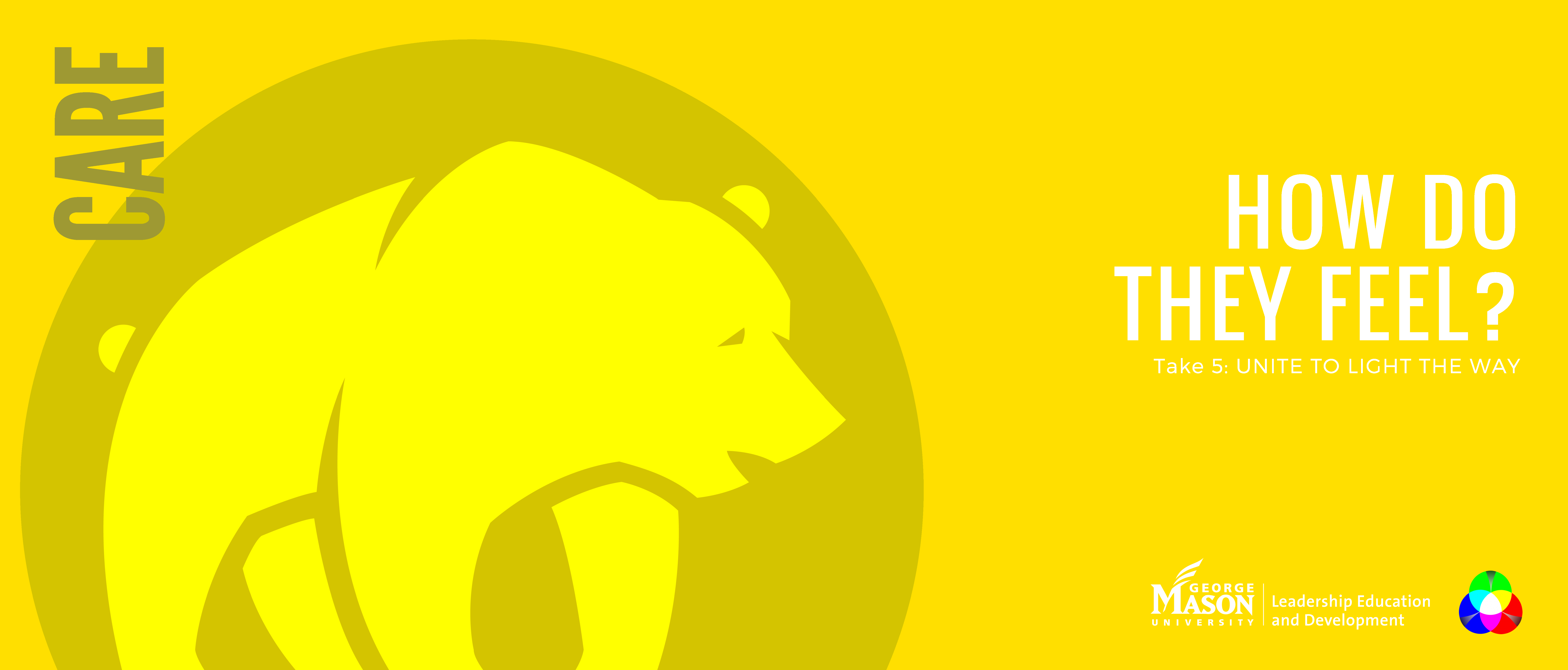BAILEY the BEAR. Focus Color: YELLOW (GOLD)
Why read the information below?
1. Have a tough decision to make? Explore the strengths and challenges of this decision-making focus.
2. Discover the benefits of uniting different focus areas (colors/animals).
3. Practically apply these resources to make better decisions individually, and in groups. For example: use the FREE Take5 card (take5.gmu.edu/ethics-card), request a workshop (email: [email protected]), etc.
Why a Bear?
Bailey, like many bears, is known for being nurturing and protective. Consider the image of a mother bear taking care of its cub. Bailey and people who prefer the Care Focus go even further than the average bear in caring for others. They care deeply about treating others well, not just their own family and friends.
Why the color Yellow/Gold?
There are 3 primary colors of light: green, red, and blue. Imagine that we have 2 flashlights that we shine in a dark room: one is green, and one is red. If we overlap green and red light, we get yellow light. The Care focus (Yellow) may be seen as a combination of aspects of the Character focus (Green Otter) and the Code focus (Red Hawk), since it includes ideas about the type of people we are striving to be (e.g. caring/compassionate) and a rule/code that it would be beneficial for all to follow (e.g., “Treat others as you/they would like to be treated”). Gold represents the Golden Rule (and Platinum Rule), since that is the main focus of Bear’s Care.
Main Consideration:
When deciding what’s right, Bailey and others with a Care Focus tend to focus on treating others as they would like to be treated. This involves putting themselves in other’s shoes (or paws, if you’re a bear). An important aspect of this focus is caring for those beyond your own family and friends.
Question:
Like Bailey, someone with a Care Focus may ask themselves: “How can I treat others as I/they would like to be treated?” They believe in the importance of trying to see things through someone else’s viewpoint.
Strengths of the Care Focus:
1. EMPATHIC MOTIVATION. Imagine that a new person joins your group/organization and the other members do not make a real effort to invite them in and welcome them. You ask yourself “how can I treat them as I/they would like to be treated?” and you realize that you should reach out to them and look for other ways to include them. You are careful not to make assumptions about what they may want or need. Instead, you introduce yourself and ask them if they’d like to join you and you begin a conversation to see if you can be of assistance. A strength of the Care focus is that it can help us to see the importance of empathy and how others would want to be treated.
2. SELF-RESTRAINT. Imagine that a friend makes up a lie about you in order to make themselves look better than you. For example, they tell others that you cheated (on a test, or on your partner) when you didn’t. You may feel that you really want to do the same to them to show them how it feels. However, because you focus on treating others as you/they would like to be treated, you reason that even though they lied about you, you would not want to be treated that way if you were them, so you do not retaliate. This does not mean that you are passive and do not say anything, or that you do not seek justice, but rather you show self-restraint and do not seek revenge. Revenge and justice can be very different. The Care focus can help us with self-restraint.
Challenges of the Care Focus:
1. SPECULATION. Sometimes, our speculation about how others want to be treated can be very wrong. Imagine that you need to give a friend or co-worker some important feedback. Some people want direct feedback without any sugarcoating, and they get upset about wasted time. They say “Just tell me directly that I’m annoying you and let’s move on. I can take it.” Others prefer to be comforted and reassured with some positive feedback before any critiques. When a critique comes too quickly or directly, they say “You really hurt my feelings” and they may not even really hear or process the feedback because of how it was delivered. We may not be aware of, or even be able to find out, how others really want to be treated. This is especially true when decisions affect many others, including those we don’t know well and people from different backgrounds. A challenge of the Care focus is that it can be very difficult to really know how others want to be treated. To help in these situations, it can be essential to do our own research and to consult with those with a different main focus (e.g., Elephant’s Consult Focus).
2. JUSTICE DENIED. Imagine that your friend Bailey needs to decide what to do about a co-worker named Mel. Mel is having a very negative influence on other co-workers by purposefully making hurtful comments. If Bailey strictly focuses on “how would I/they want to be treated?” Bailey may decide not to do anything about Mel’s behavior since that’s what Bailey would want if the roles were reversed (and what Bailey thinks Mel would want). Bailey is so strictly focused on treating others how they would like to be treated that Bailey neglects to hold others accountable for their bad behavior. Bailey also wouldn’t want to be held accountable either. A similar example is a judge who lives by the Golden/Platinum rule and does not hold a corrupt criminal accountable. The judge knows that the criminal wants to go free, and the judge would want to go free if the roles were reversed. A singular focus on the Golden/Platinum rule can sometimes lead to a lack of fairness/justice. To help in these situations, it can be essential to incorporate a different focus (e.g., Wolf’s Consequences Focus).
Theoretical Background:
Golden Rule (and Platinum Rule) or Care-based Ethics (based on the wisdom of Carol Gilligan, Confucius and others).
Conclusion:
Bailey the Bear represents a very important and respected focus area (CARE) from moral philosophy. However, it does not include everything. To balance out the challenges above, Bear’s CARE should be combined with other focus areas like Wolf’s CONSEQUENCES and the Elephant CONSULTant. Combining focus areas is called PLURALISM and can be very beneficial.
Next Steps:
1. Remind yourself of the strengths and challenges of your main focus animal/color. This can help you anticipate benefits and identify potential problems down the road. For example, if someone only focuses on the Golden Rule: “How can I treat others how I/they would like to be treated?” (Bear’s Care focus) they may not hold someone accountable for their behavior because they would not want to be held accountable if they were in the other person’s situation, leading to a lack of fairness/justice.
2. Pick at least one other focus area (another animal/color) to read more about (see take5.gmu.edu/animals/). This can help you to better understand the strengths and challenges of different decision-making strategies. It can also help you to see the benefits of uniting the focus areas, since the different focus areas can build off of one another’s strengths and counteract one another’s challenges. This is why we say “Unite to light the way.”
3. Use the Take5 card (take5.gmu.edu/ethics-card/) to help you make well-balanced decisions (individually, and in groups). This card is practical, and action focused. Print it out or email [email protected] to request a card. Research shows that we all need reminders to make more ethical decisions.
4. Request a workshop. Email [email protected] to request a workshop to better understand these ideas and resources.
Handout:
To better understand this focus area, see the PDF Handout.
Overall Conclusion about the focus areas of the animals:
The Otter, Hawk, Wolf, Bear and Elephant represent very respected views from moral philosophy. We recommend combining the views of these 5 animals to balance out their strengths and weaknesses. For some tips on how to do this, please see the ethicspectrum page.
For George Mason University community members who would like to learn more, the Center for Leadership and Intercultural Engagement (CLIE) offers workshops and other programs on ethics and leadership topics. The workshop that directly addresses the ethics and leadership topics discussed on this website is called: “What Would You Do? Making Tough Ethical Choices.” Please see our general page at lead.gmu.edu or our workshop request page.



